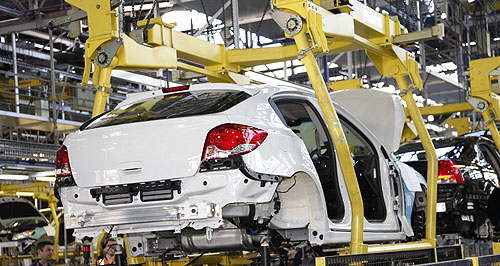Make / Model Search
News - General News - RegulationGet free-trade deal right this time: FCAISet to go: A boatload of Kia cars await export on the docks in Korea (image at bottom of story is Holden Cruze production at Elizabeth plant in Australia). Motor industry peak body flags danger signs in Pacific free trade proposal23 Nov 2011 THE Australian automotive industry has sounded a warning about the proposed 10-nation Trans-Pacific Partnership (TPP) free-trade agreement, indicating it could be another nail in the coffin of the three local vehicle manufacturers and their suppliers unless the Australian government ensures a level playing field before it signs up. The deal threatens to expose GM Holden, Ford Australia, Toyota Australia and their suppliers to the full force of competition from the Japanese car industry – and potentially China and South Korea – without the protection of the current five per cent import tariff on motor vehicles. Bilateral free-trade deals with countries such as Thailand so far have proved largely a one-way street for automotive manufacturers, with duty-free Thai-built vehicles flooding the Australian market and little going the other way, partly due to non-tariff obstacles put in the way of Australian exporters. So far this year, almost 136,000 Thai-made vehicles have been sold in Australia, out-selling local car makers’ 118,677 vehicles and already eclipsing last year’s full-year tally of 135,618 Thai vehicles, despite the recent floods. The Thai situation in particular has alarm bells ringing in Australia as Canberra commits the country to free-trade pact negotiations with nine other Pacific Rim countries – United States, Japan, Malaysia, Peru, Chile, Brunei, Singapore, Vietnam and New Zealand – under the TPP that was high on the agenda at recent talks in Bali. Australia already has trade pacts with some of these countries, including the US and New Zealand, but Japan – already the biggest source of imported vehicles sold in Australia, supplying about a third of all vehicles sold here in 2010 – is still subject to vehicle tariff restrictions. The Federal Chamber of Automotive Industries (FCAI) this week said the Australian government needs to ensure it achieved genuine reciprocal market access for Australian automotive manufacturers under any TPP deal. FCAI chief executive Ian Chalmers said that while his organisation welcomed the involvement of Australia in the TPP talks, it was conditional on equivalent access to markets. “The TPP should be a comprehensive and high quality free-trade agreement which must involve not just reciprocal reductions in tariffs, but also address non-tariff barriers (NTB) to trade,” he said. “The Australian government should ensure that all participants in these negotiations are willing and able to demonstrate action to remove NTBs before Australia engages in negotiations.” Mr Chalmers said Australia was already one of the most open and competitive automotive industries in the world, with an average tariff of about 3.5 per cent. Although Mr Chalmers did not name Thailand, he said previous free-trade agreements negotiated by Australia had not resulted in equivalent market access for automotive products. “Non-tariff barriers in particular have been used to restrict or prevent the import of motor vehicles from Australia,” he said. The FCAI said examples of non-tariff barriers used to protect auto industries included discriminatory tax structures, frequent introduction of new technical barriers, non-WTO (World Trade Organisation)-compliant customs valuation methodologies, currency manipulation and subsidised interest rates on domestically produced vehicles. The trade situation could get even more dire for Australian manufacturers if China and South Korea join the TPP. These two Asian powerhouses are reported to have expressed interest in discussing membership of the TPP, along with Taiwan, Canada, Mexico and the Philippines. China is the world’s biggest motor manufacturer, producing some of the cheapest cars in the world and aggressively targeting export markets. It has built its industry behind a 25 per cent import tariff barrier and a raft of support mechanisms from the Beijing central government and provincial governments. Among these aids are a strongly favourable exchange rate for the yuan and big subsidies for factories and other expenses. While South Korea has a vehicle import tariff of eight per cent, it too has been adept in protecting its industry from external competition. Mr Chalmers said exports of Australian-made vehicles were already under pressure due the strength of the Australian dollar, high costs and intense competition from other automotive manufacturing nations to attract investment into the next generation of low-emission vehicle technology and production. “It is essential that any future trade agreements do not result in competitive disadvantage for Australian manufacturers,” he said. GM Holden recently lost exports markets for its Commodore to Brazil and the Middle East, while Toyota warned during recent industrial action at its Altona factory in Melbourne that its Australian operation faced life and death competition for investment capital to build future new models in Australia.  Read more |
Click to shareGeneral News articlesResearch General News Motor industry news |










Facebook Twitter Instagram